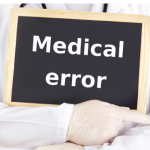Using the language of patient care to guilt physicians into working even harder than we already do is dishonest, & medical administrators should come clean about this manipulative practice.
In other words, nothing on the CT indicated whether this could wait until Monday.
So I did what you would do. I pulled over at the nearest rest stop, got some fries and pulled out my laptop so I could look up my patient’s medical records. After speaking to her, the emergency department attending and the vascular surgeon on call, I got back on the road.
About a month later, I received an email with the subject line, “FY20 DOM Faculty Plan Compensation Update,” which stated the following:
The DOM (Department of Medicine) compensation model and productivity reports have so far focused on individual productivity as measured by RVUs compared to national benchmarks, but it has always been our goal to evolve the model to incorporate quality and citizenship metrics. Beginning July 1st, earning a full end of year bonus in the DOM will be contingent on maintaining timely clinical documentation, including closing outpatient encounters, completing discharge summaries and responding to documentation queries. … For each metric, you will see a short description of the compliance standard, your year to date percent compliance with the standard as well as your performance in the most recent month. Bonus performance will be conditional on your annual performance. For performance that meets the standards set by the DOM, you will see a green check mark.
It suddenly occurred to me that what I think of as excellent healthcare and what my employer thinks of as excellent healthcare are very different.
In Search of Excellence
What does it mean to deliver excellent healthcare? Why is it that pulling over to the side of the road on my way to New York to arrange for an urgent admission for a patient I met once doesn’t earn me a green checkmark?
Early in this century, the goals of healthcare began to shift. In the 20th century, the patient was seen as a passive recipient of medical care. In the 21st century, the patient became a co-equal partner. Instead of focusing on treatment of the illness, healthcare started to focus on the wants and needs of the individual patient.1
Although patient-centered care was billed as a revolutionary concept, the concept itself was not all that new. William Osler famously opined, “The good physician treats the disease. The great physician treats the person who has the disease.”2
In truth, the rubric patient-centered care likely became popular because it was supposed to save the healthcare system money. Recipients of patient-centered care, which emphasizes a team-based approach led by a primary care provider, have fewer emergency department visits, fewer hospitalization readmissions and lower healthcare resource utilization.3
If we know we should be delivering patient-centered care, why do we fail to do it so often? Physicians commonly fail our patients two ways: biomedical errors and contextual errors. A biomedical error is a failure to make the right decision based on the medical data. A contextual error is a failure to recognize how a patient’s individual circumstances affect what might be the right decision for that patient. It would be a biomedical error to continue to prescribe methotrexate for a patient who is developing a macrocytic anemia. It would be a contextual error to prescribe methotrexate for a patient who could not afford to purchase the pills.4
In one study, physicians were asked to evaluate an actor playing the role of a patient who was contemplating knee replacement surgery. From a biomedical perspective, there were no contraindications to surgery. Only about half the physicians asked enough questions to learn that, in this scenario, she was the sole caregiver for a child who had a terminal illness and did not understand that she would be in rehabilitation during his last weeks of life.5
Why are we so bad at identifying contextual errors? I suspect it is for the same reason that my staff acts like they can’t see me when I am trying to fix a jammed printer: We feel like we don’t have enough time to get involved. Many of my patients likely don’t realize their clinic appointment is the only time I have in my week that is carved out solely to deliver their care.
When I see a patient in clinic, after completing a history and physical, I turn to the patient and say “Sorry.” And then I turn away from the patient and toward the computer monitor. I start typing and clicking, renewing orders, arranging for infusions, reviewing lab tests and placing referrals. The patient does not need to bear witness to any of this, but I know that if I don’t accomplish these tasks while the patient is looking over my shoulder, they may not get done. I am, in essence, stealing time from the patient to provide them with patient care.
I don’t steal only from my patients; I also steal from myself. The clinic day never incorporates enough time for the mechanics of patient care, so I accomplish the balance of my work at night and on the occasional weekend. You do, too. I know this because you have no choice.
In The New York Times, Danielle Ofri, MD, a physician at Bellevue Hospital, New York, wrote an article you should read. It’s titled, “The Business of Health Care Depends on Exploiting Doctors and Nurses.” She wrote:
For most doctors and nurses, it is unthinkable to walk away without completing your work because dropping the ball could endanger your patients. I stop short of accusing the system of drawing up a premeditated business plan to manipulate medical professionalism into free labor. Rather, I see it as a result of administrative creep. One additional task after another is piled onto the clinical staff members, who can’t—and won’t—say no. Patients keep getting their medications and their surgeries and their office visits. From an administrative perspective, all seems to be purring along just fine. But it’s not fine.6
The solution may lie in one single fact: For every physician, there are 10 medical administrators. Over the next 10 years, medical administrator positions are expected to grow by 17%. Positions for physicians over the same period of time will grow by only 14%.7 The business of healthcare has become more important than the delivery of healthcare itself. If the growth in medical administrator positions could be made linear rather than exponential, the surplus funds could be used to pay for people who actually deliver healthcare, rather than pay for people who supervise others doing that important work.
When new duty-hour limits were imposed on trainees, we were often compared with pilots, who need to be well rested to safeguard the lives in their hands. What no one seems to mention is that when their shift is over, those same pilots just leave. They feel no responsibility to keep working until every passenger is safely home. When the repairs to my car are running late, my mechanic doesn’t take my car home with him and work on it after dinner. Nor would I expect him to. The expectation up until now has been that physicians should work until the work is done, without regard to time or compensation. This expectation is a vestige of the days when physicians acted in loco parentis, and as our specialty moves from parentalism toward patient-centered care, we should start to admit this expectation is just plain loco.
Perhaps surprisingly, I have every confidence this problem will eventually resolve itself. Medical students are already asking me about work-life balance. I have a feeling their generation will not meekly type away at their electronic medical record on a Saturday night.



